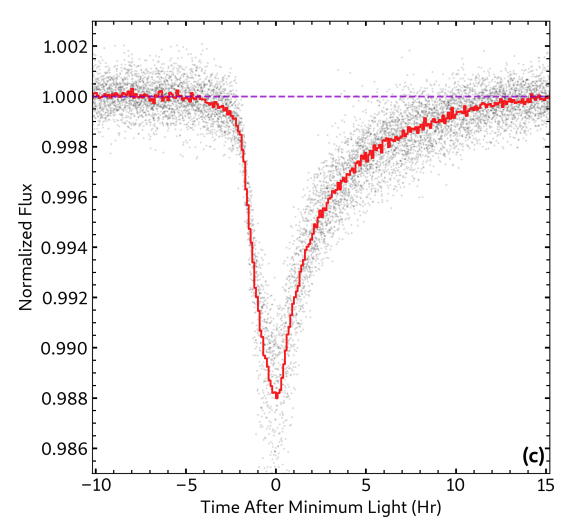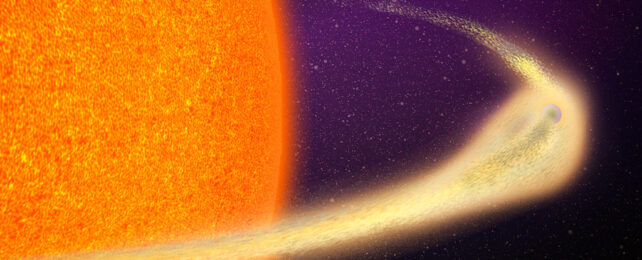Astronomers have discovered one of the least habitable planets ever. This tiny world is being melted by its host star, leaving a comet-like tail that stretches millions of kilometers behind it.
While we're often preoccupied with planets that might be comfy enough for liquid water to pool on the surface, the hellish landscape of BD+05 4868 Ab hosts liquid rock. These magma oceans are boiling right off the surface into space, condensing into a rocky tail.
"The extent of the tail is gargantuan, stretching up to 9 million kilometers [5.6 million miles] long, or roughly half of the planet's entire orbit," says Marc Hon, astrophysicist at MIT's Kavli Institute.
The unfortunate planet lies about 140 light-years away, orbiting its host star every 30.5 hours. That brings it about 20 times closer to the star than Mercury orbits the Sun – and cuddling up that close could prove to be a lethal mistake.
BD+05 4868 Ab may have started out with more than double its current mass, which seems to be less than half that of Mercury, and it's getting smaller all the time. The researchers estimate that it ejects a Mount Everest's-worth of material into space with every orbit, and at that rate it will completely dissolve within 1 or 2 million years.
"This is a very tiny object, with very weak gravity, so it easily loses a lot of mass, which then further weakens its gravity, so it loses even more mass," says Avi Shporer, astronomer on the Transiting Exoplanet Survey Satellite (TESS) mission.
"It's a runaway process, and it's only getting worse and worse for the planet."
It's only the fourth melting Mercury exoplanet discovered so far, but it has the poorest prognosis. One orbiting KIC 12557548, for example, has been given about 200 million years to live. But BD+05 4868 Ab's extensive tail is a symptom of a much faster disintegration.
Other tailed exoplanets have been discovered before, but they're usually gas giants with plenty of material to spare. HAT-P-32b, for instance, is leaking helium into two tails that span more than 53 times the planet's radius. It will probably take another 40 billion years before it evaporates completely.
The hot Jupiter WASP-69b is also losing its atmosphere to a tail, although it's only shrinking by one Earth mass every billion years. It'll likely face other, more pressing apocalypses, like its star blowing up, long before it needs to worry about running out of air.
But back to BD+05 4868 Ab. This extraordinary exoplanet was discovered in an ordinary way, using the transit method. This involves watching a star for periodic dips in brightness, caused by a planet passing between it and the telescope viewing it.

But in this case, the astronomers didn't just see a brief and regular dimming. It took much longer than expected for the brightness to return to normal after each transit. Weirder still, the amount of light filtering through during each orbit varied. That suggested that a fuzzy, inconsistent structure was trailing behind the transiting object.
"The shape of the transit is typical of a comet with a long tail," says Hon. "Except that it's unlikely that this tail contains volatile gases and ice as expected from a real comet – these would not survive long at such close proximity to the host star. Mineral grains evaporated from the planetary surface, however, can linger long enough to present such a distinctive tail."
Intriguingly, there's also a much smaller 'leading' tail that stretches out in front of the planet. The team says this could be especially useful to help us understand the dust tail's dynamics and test formation theories.
It won't top anyone's list of holiday destinations, but BD+05 4868 Ab may still have something to teach us about more hospitable worlds. After all, it's not often that a planet blasts its innards outwards for us to analyze.
JWST could perform this autopsy, studying the spectrum of the star's light as it's absorbed by the dust to reveal what the doomed planet is made of.
"This will be a unique opportunity to directly measure the interior composition of a rocky planet, which may tell us a lot about the diversity and potential habitability of terrestrial planets outside our Solar System," says Hon.
The research was published in The Astrophysical Journal Letters.
